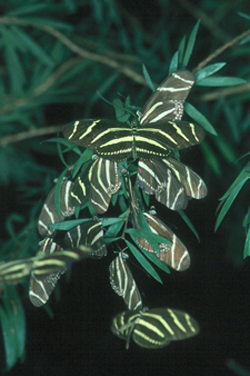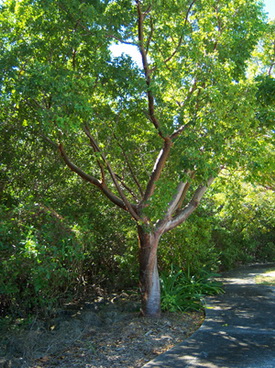
Exhibit highlights butterflies found in park
HOMESTEAD, Fla. — It’s wonderful what can be found on only five percent of land at Biscayne National Park. From state-of-the-art exhibits to a Community Artist Gallery and auditorium, the park preserves some of its most delicate species by combining science and art.
Located at the Dante Fascell Visitor Center in Homestead, the Community Artist Gallery featured “Butterflies of Biscayne,” an exhibition in which members of the Miami Blue Chapter of the North American Butterfly Association (NABA) put together. The photography exhibit was recently displayed from Sept. 11 to Nov. 15.
| Featured at the Butterflies of Biscayne exhibit, the Schaus’ Swallowtail butterfly is federally endangered and endemic to Biscayne National Park (Photo courtesy of Rick Cech). |  |
|
| Of the 64 species found in the park, 25 are present in limited numbers and can be seen in wooded areas (Photo by Cindy Acosta). |  |
|
| The rare Miami Blue butterfly (Photo courtesy of David L. Lysinger). Below, top, the Zebra Heliconian is the official state butterfly (Photo courtesy of NABA). Below, bottom, aside from the butterfly garden at the park, butterflies may be found anywhere there are flowers and sun (Photo by Cindy Acosta).
|
 |
“[The exhibit] is called a ‘field guide on the walls’ by club members,” Biscayne National Park Ranger Gary Bremen said.
From the rare Schaus Swallowtail, found only at Biscayne and other islands of the Northern Florida Keys, to the common Zebra Longwing, Florida’s State Butterfly, the exhibit blended science and art as photographs by James Spencer and Michelle Wisniewski of Monroe County and Ron Nuehring of Miami-Dade County, to name a few, were displayed alongside the details of each butterfly.
The inspiration for the exhibit, according to Nuehring, included “multiple factors.” Nuehring stated that the project started with an appreciation for the beauty of even the least colorful of these animals, and an interest among several of the Chapter’s members in macro photography.
 “The goal, however, became an effort to increase public awareness of the natural world, and the fragility of the ecosystem(s) upon which we all rely,” Nuehring said. “An appreciation for these creatures can lead to an appreciation of the world we live in and our need to conserve our natural resources for future generations. So in the end, education became the driving force.”
“The goal, however, became an effort to increase public awareness of the natural world, and the fragility of the ecosystem(s) upon which we all rely,” Nuehring said. “An appreciation for these creatures can lead to an appreciation of the world we live in and our need to conserve our natural resources for future generations. So in the end, education became the driving force.”
Of the 64 species found in the park, 27 butterflies are “common” while 25 are “present in limited numbers.”
Although the park has its own butterfly garden located near the park’s Convoy Point entrance, butterflies can be found in open woods or edges of wooded areas, disturbed weedy areas, and along the coastal littoral zone.
“Zebras and Swallowtails,” said Matthew Johnson, a Biscayne National Park ranger, are the butterflies most likely to be found this time of year along the wooded trails.
Although there are 27 common butterflies to be found, photographing them can be a real challenge. According to Nuehring, capturing the detail and beauty of creatures this small requires patience and a basic understanding of their biology,
including physiology and life styles.
While most of the photographs printed for this exhibit were taken by photographers using advanced camera systems, Nuehring added that several were taken with entry level point-and-shoot digital cameras.
“One of our more advanced photographers is wheel chair bound,” Nuehring said. “Her photos were taken using a camera mounted on the electric cart she requires for mobility — a real challenge for subjects this small.”
Endemic to Biscayne National Park, the Schaus’ Swallowtail Butterfly, Heraclides aristodemus ponceanus, was displayed apart from the others in the exhibit.
Discovered in Miami in 1898 by Dr. William Schaus, a Spanish-American War physician, the Schaus was federally listed as threatened in 1976 and endangered in 1984.
 Aside from exotic threats, predatory ants and draught conditions that can obliterate butterflies, the Schaus may be found in dry tropical hardwood hammocks and surrounding scrub.
Aside from exotic threats, predatory ants and draught conditions that can obliterate butterflies, the Schaus may be found in dry tropical hardwood hammocks and surrounding scrub.
Its adult life span consists of three and a half days in the wild and up to one month in a protected laboratory. Its life cycle relies on fresh new plant growth.
Along with the Schaus Swallowtail, the Miami Blue Chapter of the NABA featured a variety of butterflies. Formed in 2000, the Miami Blue Chapter is located in Coral Gables and is named after one of Florida’s rarest butterflies.
The Miami blue, Cyclargus thomasi bethunebakeri, is a small, brightly colored butterfly that is limited in range and numbers. Once widespread and locally common across South Florida, the butterfly is endangered due to ever-expanding urbanization and the loss of coastal habitat. Today, the Miami blue is limited to a few wild populations in the Lower Florida Keys such as Bahia Honda State Park.
Aside from exhibitions, the Miami Blue Chapter holds lecture series and field trips as part of the NABA.
“At best, we can hope to increase public awareness in an effort to motivate conservation of habitat and the resources of the ecosystems in our natural environment,” Nuehring said. “Since human development poses the biggest threat to our natural environment, education to promote conservation has to be an ongoing initiative.”

If You Go:
- Dante Fascell Visitor Center, Biscayne National Park, 9 a.m. to 5 p.m. daily, located at 9700 SW 328th St., Homestead; free. 305-230-7275 or www.nps.gov/bisc.
- From the Florida turnpike, take exit 6 and follow the signs. The center is nine miles east of U.S. 1 on North Canal Drive.
Butterfly Viewing Tips:
- According to the Miami Blue Chapter, simple common sense is important when looking for butterflies in South Florida. Wide-brimmed hats, mosquito repellent, water, field guides, close-focus binoculars and a watchful eye for seldom encountered venomous snakes are excellent prerequisites.
- Above all, the chapter advises viewers to be respectful of butterfly habitat. Don’t trample on potential nectar source plants or unnecessarily handle larval host plants. Some of the smallest and rarest butterflies lay tiny, almost invisible eggs, which are followed by tiny vulnerable caterpillars.
- The largest group in North America interested in the study and protection of butterflies, the NABA is a membership-based, non-profit organization working to increase public enjoyment and conservation of butterflies. Regular membership is $30, family membership is $40. Benefits include a subscription to NABA’s quarterly magazines, American Butterflies and The Butterfly Gardener, as well as local and out-of-town field trips and family-orientated events among others.
Information graphic created by Tia Dawkins-Hendricks.

Comments are Closed